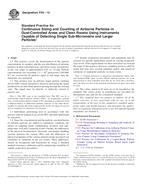Potřebujeme váš souhlas k využití jednotlivých dat, aby se vám mimo jiné mohly ukazovat informace týkající se vašich zájmů. Souhlas udělíte kliknutím na tlačítko „OK“.
ASTM F50-12
Standard Practice for Continuous Sizing and Counting of Airborne Particles in Dust-Controlled Areas and Clean Rooms Using Instruments Capable of Detecting Single Sub-Micrometre and Larger Particles
Automaticky přeložený název:
Standardní praxe Sekvenční dimenzování a počítání vzdušných částic prachu kontrolovaných oblastí a čisté pokoje s využitím nástrojů schopen detekovat Single Sub-mikrometrů a větších částic
NORMA vydána dne 1.4.2012
Informace o normě:
Označení normy: ASTM F50-12
Poznámka: NEPLATNÁ
Datum vydání normy: 1.4.2012
Kód zboží: NS-55546
Počet stran: 6
Přibližná hmotnost: 18 g (0.04 liber)
Země: Americká technická norma
Kategorie: Technické normy ASTM
Anotace textu normy ASTM F50-12 :
Keywords:
air sampling, airborne particles, particle counting, particle size distribution, particles, Atmospheric analysis, Calibration--semiconductor analysis instrumentation, Cleanrooms (materials/applications), Counting airborne particles, Dust-controlled areas, Light scattering, Particle counters/counting, Particulate contamination (aerospace environments), Pulse height, Size/size distribution analysis, ICS Number Code 13.040.30 (Workplace atmospheres)
Doplňující informace
| Significance and Use | ||||||||||||||
|
The primary purpose of this practice is to describe a procedure for collecting near real-time data on airborne particle concentration and size distribution in clean areas as indicated by single particle counting techniques. Implementation of some government and industry specifications requires acquisition of particle size and concentration data using an SPC. The processing requirements of many products manufactured in a clean room involves environmental cleanliness levels so low that a single particle counter with capability for detecting very small particles is required to characterize clean room air. Real-time information on concentration of airborne particles in size ranges from less than 0.1 μm to 5 μm and greater can be obtained only with an SPC. Definition of particles larger than approximately 0.05 μm may be carried out with direct measurement of light scattering from individual particles; other techniques may be required for smaller particles, such as preliminary growth by condensation before particle measurement. Particle size data are referenced to the particle system used to calibrate the SPC. Differences in detection, electronic and sample handling systems among the various SPCs may contribute to differences in particle characterization. Care must be exercised in attempting to compare data from particles that vary significantly in composition or shape from the calibration base material. Variations may also occur between instruments using similar particle sensing systems with different operating parameters. These effects should be recognized and minimized by using standard methods for SPC calibration and operation. In applying this practice, the fundamental assumption is made that the particles in the sample passing through the SPC are representative of the particles in the entire dust-controlled area being analyzed. Care is required that good sampling procedures are used and that no artifacts are produced at any point in the sample handling and analysis process; these precautions are necessary both in verification and in operation of the SPC. |
||||||||||||||
| 1. Scope | ||||||||||||||
|
1.1 This practice covers the determination of the particle concentration, by number, and the size distribution of airborne particles in dust-controlled areas and clean rooms, for particles in the size range of approximately 0.01 to 5.0 μm. Particle concentrations not exceeding 3.5 × 106 particles/m3 (100 000/ft3) are covered for all particles equal to and larger than the minimum size measured. 1.2 This practice uses an airborne single particle counting device (SPC) whose operation is based on measuring the signal produced by an individual particle passing through the sensing zone. The signal must be directly or indirectly related to particle size. Note 1—The SPC type is not specified here. The SPC can be a conventional optical particle counter (OPC), an aerodynamic particle sizer, a condensation nucleus counter (CNC) operating in conjunction with a diffusion battery or differential mobility analyzer, or any other device capable of counting and sizing single particles in the size range of concern and of sampling in a cleanroom environment. 1.3 Individuals performing tests in accordance with this practice shall be trained in use of the SPC and shall understand its operation. 1.4 Since the concentration and the particle size distribution of airborne particles are subject to continuous variations, the choice of sampling probe configuration, locations and sampling times will affect sampling results. Further, the differences in the physical measurement, electronic and sample handling systems between the various SPCs and the differences in physical properties of the various particles being measured can contribute to variations in the test results. These differences should be recognized and minimized by using a standard method of primary calibration and by minimizing variability of sample acquisition procedures. 1.5 Sample acquisition procedures and equipment may be selected for specific applications based on varying cleanroom class levels. Firm requirements for these selections are beyond the scope of this practice; however, sampling practices shall be stated that take into account potential spatial and statistical variations of suspended particles in clean rooms. Note 2—General references to cleanroom classifications follow Federal Standard 209E, latest revision. Where airborne particles are to be characterized in dust-controlled areas that do not meet these classifications, the latest revision of the pertinent specification for these areas shall be used. 1.6 The values stated in SI units are to be regarded as the standard. The values given in parentheses are provided for information only and are not considered standard. 1.7 This standard does not purport to address all of the safety concerns, if any, associated with its use. It is the responsibility of the user of this standard to establish appropriate safety and health practices and determine the applicability of regulatory limitations prior to use. For specific hazards statements, see Section 8. |
||||||||||||||
| 2. Referenced Documents | ||||||||||||||
|




 Cookies
Cookies
